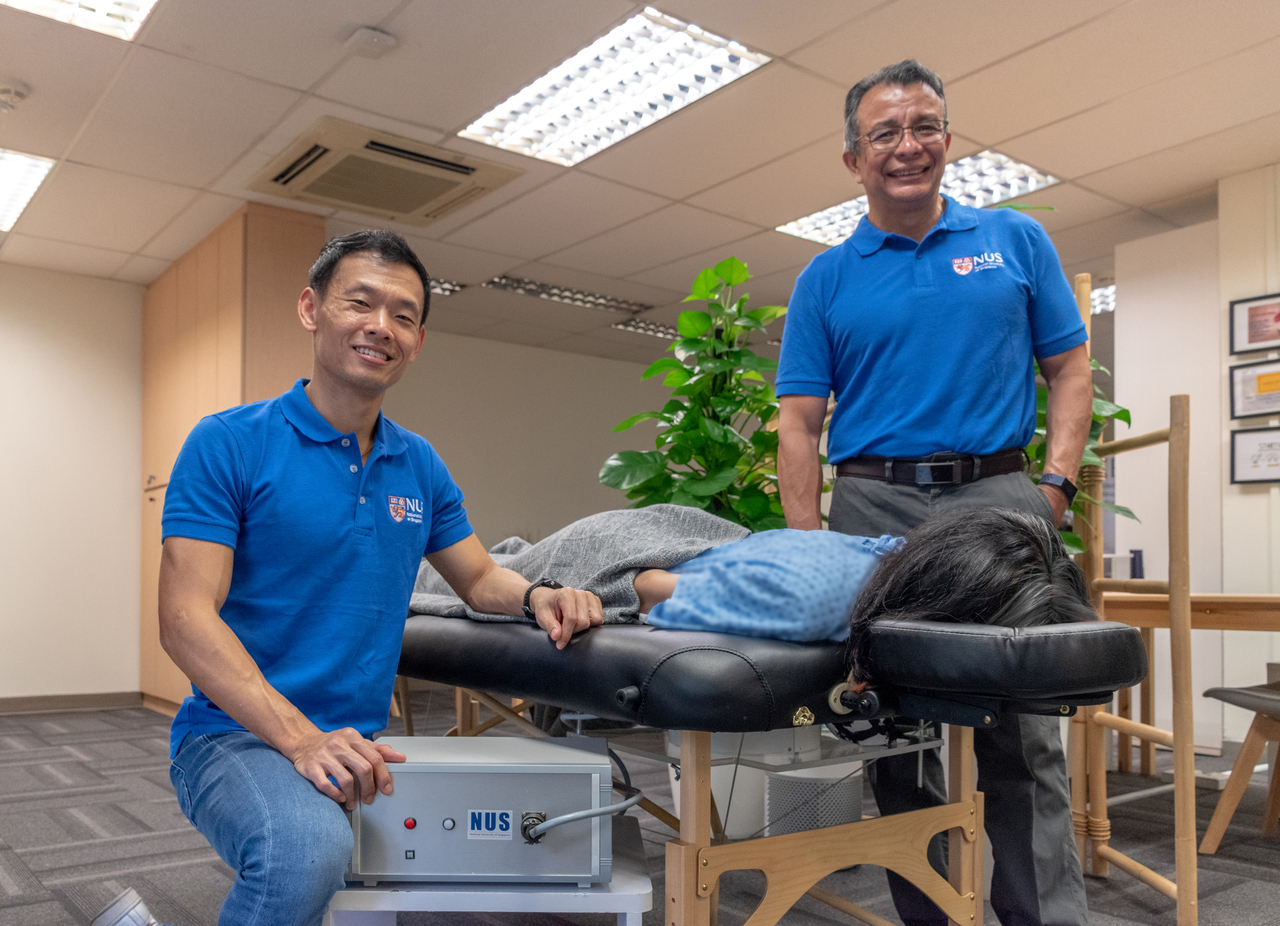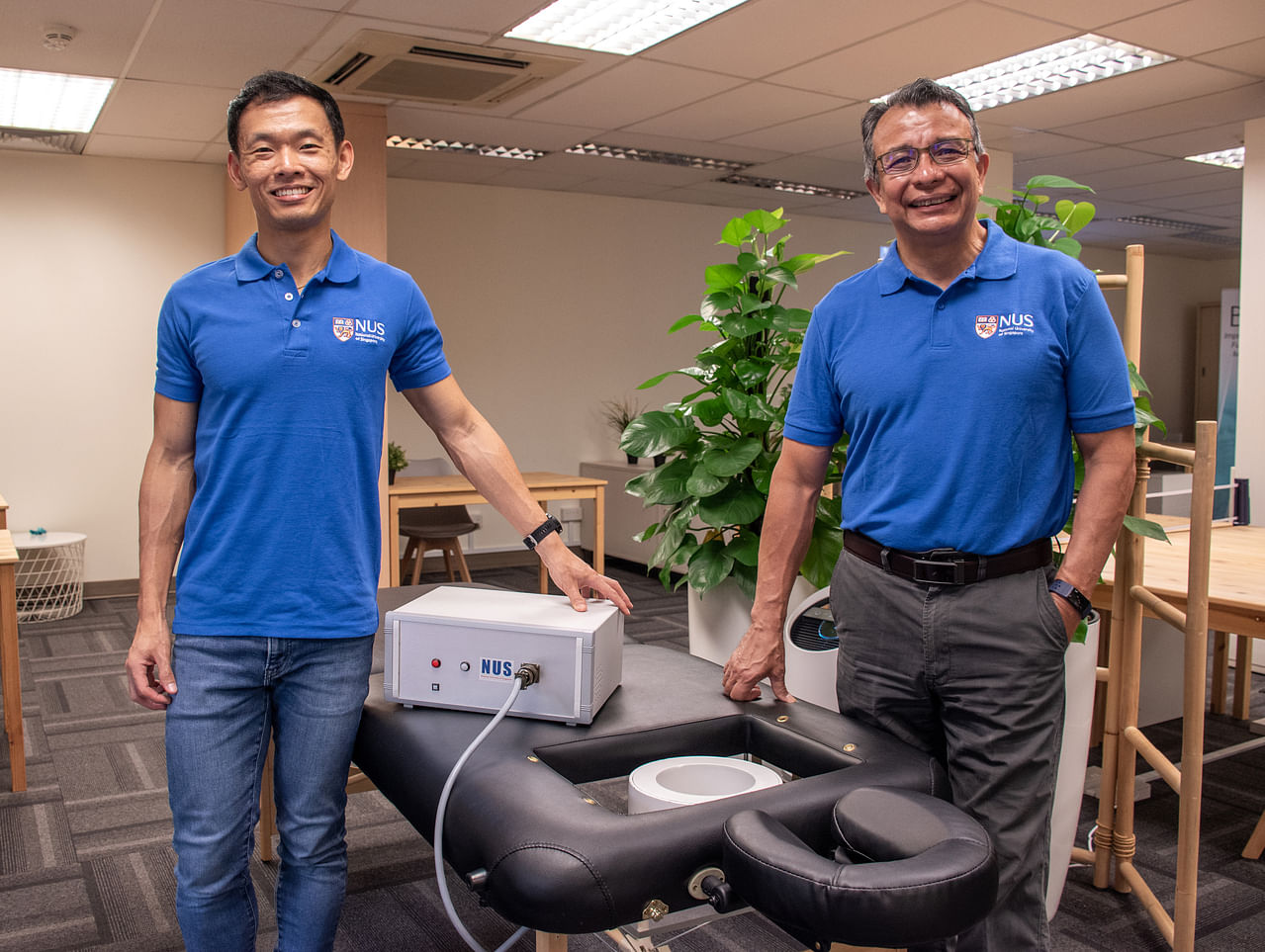NUS scientists develop painless way to shrink breast cancer using magnetic fields
Sign up now: Get ST's newsletters delivered to your inbox

Senior research fellow Alex Tai (left) and Associate Professor Alfredo Franco-Obregon demonstrate magnetic therapy.
PHOTO: NATIONAL UNIVERSITY OF SINGAPORE
Follow topic:
SINGAPORE - Scientists from the National University of Singapore (NUS) have found a painless way to kill breast cancer cells by exposing them to a pulsed magnetic field.
They hope that this method will reduce the dosage needed for chemotherapy in the future, so that patients will have fewer side effects.
The treatment uses magnetic pulses to stimulate respiration in the cancer cells, which have elevated levels of a protein, TRPC1, that is especially sensitive to the stimulation.
When exposed to the magnetic field, these cells essentially hyperventilate and eventually die.
Pre-clinical trials have shown that the magnetic treatment targets only cancer cells, unlike chemotherapy and radiation therapy, which can also damage healthy cells.
Magnetic fields can also target hidden cancer cells within a tumour that chemotherapy drugs travelling through the bloodstream cannot reach, said Associate Professor Alfredo Franco-Obregon from the NUS Institute for Health Innovation and Technology (iHealthtech), who led the development of the magnetic technology.
When undergoing the magnetic treatment, the patient lies face down on a therapy bed which has an opening for the chest region. The magnetic device - a short, hollow cylinder - is placed below the opening.
Once the device is powered up, a pulsed magnetic field similar in strength to what a hairdryer produces is emitted to the tumour and cancer cells.
The team said the strength of the device's magnetic field is about 50 times greater than that of the earth's, but 1,000 times smaller than conventional magnetic resonance imaging (MRI). One treatment session would take an hour.
The NUS research team is planning to start a one-year clinical trial with the National University Cancer Institute, Singapore (NCIS) in the second half of this year, to determine the safety of the device. About 30 breast cancer patients will be involved.
The patients will try out the device for 30 to 60 minutes.
Clinicians will look out for any side effects such as toxicities or skin changes, and track any effects on wound healing after breast surgery, for instance, said Dr Joline Lim, a consultant at NCIS' Department of Haematology-Oncology.
Research on the use of electromagnetism to fight cancer is ongoing globally. An Israel-born company has developed a helmet-like device that sends electric fields to brain cancer cells to disrupt their replication.
Prof Franco-Obregon noted that other existing electromagnetic therapies use a different way of delivering the magnetic fields that also stop healthy and necessary cells from dividing.
For those therapies, the magnetic fields are of a higher frequency and patients need continuous exposure for several hours.

The magnetic therapy device (centre) emits a pulsed magnetic field that has been shown to kill breast cancer cells.
PHOTO: NATIONAL UNIVERSITY OF SINGAPORE (NUS)
Once the NUS device is deemed safe when used on its own, it will be tested alongside chemotherapy - to further prove that the treatment does not add to side effects that chemo patients already face.
Should the device clear the safety phase, clinical trials will look at the therapy's effectiveness in bolstering breast cancer treatment.
"This is when we want to find out if this machine alongside chemotherapy is really better than just chemotherapy alone," said Dr Lim.
If the magnetic treatment helps shrink the breast tumour, it also increases the chances of having clean surgery with all the cancer removed.
If patients are fortunate enough to have no cancer cells in their removed tumours and breast tissues after chemo, they are likely to have a better outcome compared with patients who have some cancer cells in the removed tissues after chemo, added Dr Lim.
Prof Franco-Obregon said the device did not cause any significant side effects during pre-clinical trials, and a combination of magnetic therapy and chemotherapy was more effective in reducing the size of breast cancer tumours than either treatment by itself.
"The ultimate hope is that the combination is so effective that it reduces the dosage for chemo and its associated side effects in patients," he added.
The research findings from Prof Franco-Obregon's team - which includes researchers from iHealthtech and the NUS Yong Loo Lin School of Medicine's department of surgery - were published in scientific journal Frontiers In Oncology in January this year.
Breast cancer is the most common cancer among women here, with about six women diagnosed with the disease each day.
Dr Lim noted that early detection is becoming more common now, with more women getting screened early, through yearly mammograms and monthly self-examinations.
The NUS team is planning to test its magnetic therapy on prostate cancer as well, since the disease shares many similarities with breast cancer.
The breast cancer-fighting device builds on work that Prof Franco-Obregon and his team did a few years ago that targeted the same TRPC1 protein, but for a wholly different reason.
When an elderly patient slid his arm or leg into that earlier magnetic field-generating cylindrical machine, it activated the TRPC1 proteins in the limb, and the muscles responded as if the patient had just exercised, helping to improve muscle function.
Prof Franco-Obregon said there is growing evidence that exercise releases agents in the body that can slow cancer growth.
Someday, he hopes patients can use the machine and magnetic therapy together, so that muscle cells can be an additional weapon against cancer.

